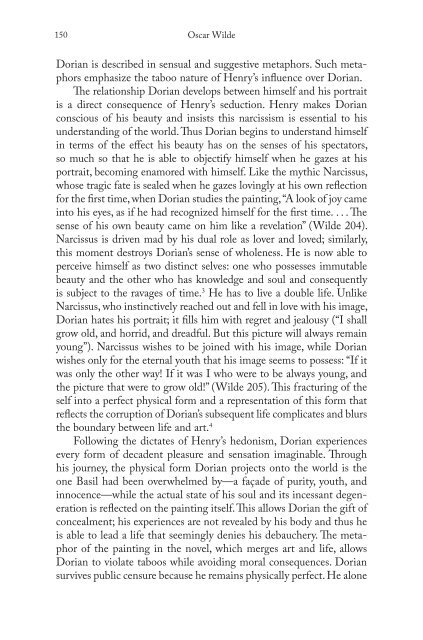Bloom's Literary Themes - ymerleksi - home
Bloom's Literary Themes - ymerleksi - home
Bloom's Literary Themes - ymerleksi - home
Create successful ePaper yourself
Turn your PDF publications into a flip-book with our unique Google optimized e-Paper software.
150<br />
Oscar Wilde<br />
Dorian is described in sensual and suggestive metaphors. Such metaphors<br />
emphasize the taboo nature of Henry’s influence over Dorian.<br />
The relationship Dorian develops between himself and his portrait<br />
is a direct consequence of Henry’s seduction. Henry makes Dorian<br />
conscious of his beauty and insists this narcissism is essential to his<br />
understanding of the world. Thus Dorian begins to understand himself<br />
in terms of the effect his beauty has on the senses of his spectators,<br />
so much so that he is able to objectify himself when he gazes at his<br />
portrait, becoming enamored with himself. Like the mythic Narcissus,<br />
whose tragic fate is sealed when he gazes lovingly at his own reflection<br />
for the first time, when Dorian studies the painting, “A look of joy came<br />
into his eyes, as if he had recognized himself for the first time. . . . The<br />
sense of his own beauty came on him like a revelation” (Wilde 204).<br />
Narcissus is driven mad by his dual role as lover and loved; similarly,<br />
this moment destroys Dorian’s sense of wholeness. He is now able to<br />
perceive himself as two distinct selves: one who possesses immutable<br />
beauty and the other who has knowledge and soul and consequently<br />
is subject to the ravages of time. 3 He has to live a double life. Unlike<br />
Narcissus, who instinctively reached out and fell in love with his image,<br />
Dorian hates his portrait; it fills him with regret and jealousy (“I shall<br />
grow old, and horrid, and dreadful. But this picture will always remain<br />
young”). Narcissus wishes to be joined with his image, while Dorian<br />
wishes only for the eternal youth that his image seems to possess: “If it<br />
was only the other way! If it was I who were to be always young, and<br />
the picture that were to grow old!” (Wilde 205). This fracturing of the<br />
self into a perfect physical form and a representation of this form that<br />
reflects the corruption of Dorian’s subsequent life complicates and blurs<br />
the boundary between life and art. 4<br />
Following the dictates of Henry’s hedonism, Dorian experiences<br />
every form of decadent pleasure and sensation imaginable. Through<br />
his journey, the physical form Dorian projects onto the world is the<br />
one Basil had been overwhelmed by—a façade of purity, youth, and<br />
innocence—while the actual state of his soul and its incessant degeneration<br />
is reflected on the painting itself. This allows Dorian the gift of<br />
concealment; his experiences are not revealed by his body and thus he<br />
is able to lead a life that seemingly denies his debauchery. The metaphor<br />
of the painting in the novel, which merges art and life, allows<br />
Dorian to violate taboos while avoiding moral consequences. Dorian<br />
survives public censure because he remains physically perfect. He alone
















